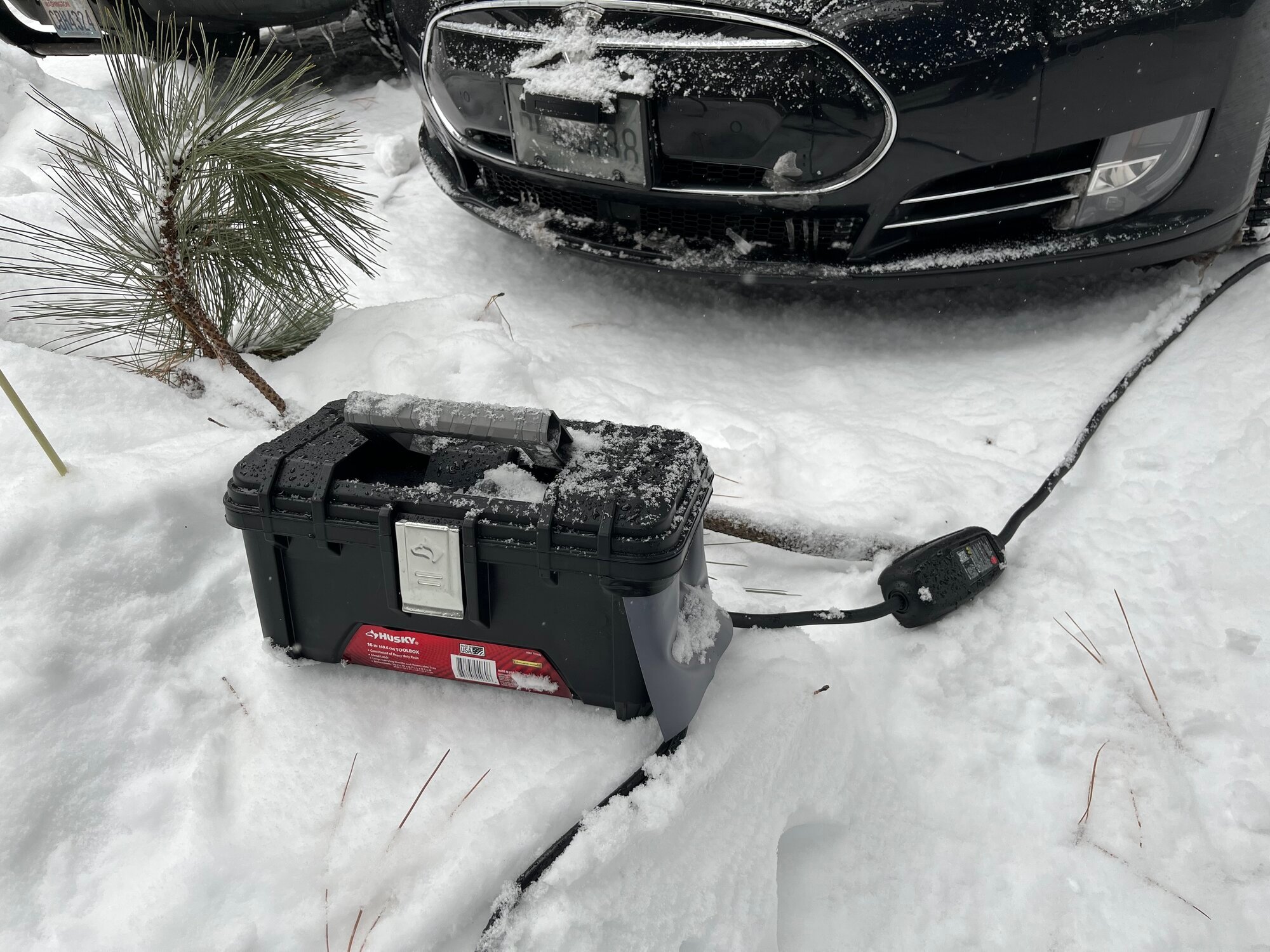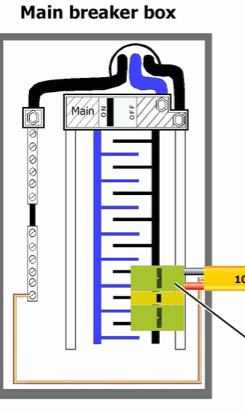Welcome to Tesla Motors Club
Discuss Tesla's Model S, Model 3, Model X, Model Y, Cybertruck, Roadster and More.
Register
Install the app
How to install the app on iOS
You can install our site as a web app on your iOS device by utilizing the Add to Home Screen feature in Safari. Please see this thread for more details on this.
Note: This feature may not be available in some browsers.
-
Want to remove ads? Register an account and login to see fewer ads, and become a Supporting Member to remove almost all ads.
You are using an out of date browser. It may not display this or other websites correctly.
You should upgrade or use an alternative browser.
You should upgrade or use an alternative browser.
Anyone using Quick220 to charge at 220V using 110V outlets?
- Thread starter alekaras
- Start date
GtiMart
Active Member
Not using it but have seen a couple youtube videos that talk about it. You need to find (and reach) two separate 120V circuits, and I think they need to be on separate busses from your 240V source, similar to a 240V breaker tapping into both 120V sources to make a 240V difference. That in itself might be tough as nothing is marked as such. After that, you need those circuits to be unused if you want to pull the full 12A from them.
I would not use such a device.
If you know for a fact that the outlets are wired correctly, and that you can find two outlets within 6 (12) feet of each other that are on opposite phases, it might work fine. Otherwise best case, it will not provide any advantage. Worst case you could have a moment of extreme excitement and perhaps a fire. IMO, very dangerous and likely not effective (finding two outlets on opposite phases is unlikely)
If you know for a fact that the outlets are wired correctly, and that you can find two outlets within 6 (12) feet of each other that are on opposite phases, it might work fine. Otherwise best case, it will not provide any advantage. Worst case you could have a moment of extreme excitement and perhaps a fire. IMO, very dangerous and likely not effective (finding two outlets on opposite phases is unlikely)
M3BlueGeorgia
Active Member
It requires the home owner to find two 5-15 outlets that are on different breakers and also on the opposite phase. Possible, but tricky.
North American have a two phase supply (the grid uses 3), so that houses can have 240v by combining two phases, and regular 120v outlets by having one or the other phase.
If you want to have a lower amperage outlet, have an electrician install a 6-20 (welder) outlet for you. (240v 20a)
Benefits of lower amperage are a thinner wire easier to pull through walls and it takes less from your breaker box.
North American have a two phase supply (the grid uses 3), so that houses can have 240v by combining two phases, and regular 120v outlets by having one or the other phase.
If you want to have a lower amperage outlet, have an electrician install a 6-20 (welder) outlet for you. (240v 20a)
Benefits of lower amperage are a thinner wire easier to pull through walls and it takes less from your breaker box.
GtiMart
Active Member
In my mind this device is aimed at charging when travelling to remote locations, to get a bit more speed (double) than a 5-15. If you are thinking about it for home charging, as the others say you're much better off getting ANY hardwired plug, whatever maximum your panel and wallet can afford, or a wall charger in the best case.
I do have one of these. It is not at all dangerous, but it's also not useful.
First off, it can't work on GFCI outlets. All outdoor outlets and garage outlets are required to be GFCI, so you already have a problem with not being able to plug it in near where your car is.
So then you would have to find two circuits in your house somewhere in different rooms that are on opposite phases, which means probably stringing extension cords around your house. The Quick220 device is nicely made, though, where it has indicator lights where you can just keep plugging into various places, and then it will display a success light when you have it right.
So it is just very cumbersome and very unlikely where you will have a situation where it would be practical to use. I got it back in 2014 and in Idaho, where charging resources were extremely scarce, and I wanted to have more options. Never used it. And really, it's 2021 now. You will never have a situation where you are this much out of range of more useful charging resources.
Searching would have been good. Here are previous threads about it:

 teslamotorsclub.com
teslamotorsclub.com

 teslamotorsclub.com
teslamotorsclub.com

 teslamotorsclub.com
teslamotorsclub.com

 teslamotorsclub.com
teslamotorsclub.com

 teslamotorsclub.com
teslamotorsclub.com

 teslamotorsclub.com
teslamotorsclub.com
First off, it can't work on GFCI outlets. All outdoor outlets and garage outlets are required to be GFCI, so you already have a problem with not being able to plug it in near where your car is.
So then you would have to find two circuits in your house somewhere in different rooms that are on opposite phases, which means probably stringing extension cords around your house. The Quick220 device is nicely made, though, where it has indicator lights where you can just keep plugging into various places, and then it will display a success light when you have it right.
So it is just very cumbersome and very unlikely where you will have a situation where it would be practical to use. I got it back in 2014 and in Idaho, where charging resources were extremely scarce, and I wanted to have more options. Never used it. And really, it's 2021 now. You will never have a situation where you are this much out of range of more useful charging resources.
Searching would have been good. Here are previous threads about it:
Quick 220 system?
Quick 220 Systems - Electric Vehicle Charging – Tesla I have to open up the cement floor to my garage to get 240 in my garage so think about using this quick 220 system converter. What do you guys think about it?
DIY Tesla 240V Charging | Quick220 Review
My Review of the Quick220 Charging System: Quick220: 220 and 240 Voltage Converters for Everyday Use Tesla Adapter: Tesla — NEMA 6-15 Extension Cord: US Wire 74050 12/3 50-Foot SJTW Yellow Heavy Duty Lighted Plug Extension Cord - - Amazon.com My sister came over during Thanksgiving and did...
Charging while renting (quick220)
Hey guys, I just wanted to post a quick video of me rambling (sorry lol) about charging while being a renter and using a quick220 to charge faster. Its about my volt, but will apply to my upcoming model 3. Hope it helps anyone who needs it. Ill be posting lots more volt/ev/tech videos so stay...
Quick220 Power Supply
I am considering purchasing the Quick220 Power Supply for a vacation so I can charge quicker than 110v at the house we are renting. Does anyone have any experience with these? Are there solutions that are better? I was thinking about purchasing a long extension cord for the 240v dryer outlet...
Two separate 120 volt / 15 amp outlets combined?
How fast would something like this charge compared to a "real" 10-30 dryer plug. Any reviews here? Quick 220
Charging my Tesla using a Quick220 power supply box
I shot a video showing charging using the NEMA 6-15 Tesla adapter and a Quick 220 converter box. Let me know what you think.
I rigged up an adapter to use and made a video explaining how it works. It basically doubles your charge from about 1.5 to 3kW. Most kitchens have the plug you need with separate circuits so you can plug a kettle and toaster without blowing the breaker. That plug has 220v between the short sockets. The link is here:
I am travelling up north with no super chargers. I rigged this up in case I need it as the 220v stove or dryer plug is too far from the car. Make sure to use solid connections, a proper ground and extension cord capable of 15A
Here in California, at least, residential customers are fed from a single phase distribution system. A typical single family home residential transformer has a 12kV primary input and a 240v output between the two outside legs with a center tap that is used as a neutral. Between the two hot wires there is 240 volts and either hot wire to neutral measures 120v.It requires the home owner to find two 5-15 outlets that are on different breakers and also on the opposite phase. Possible, but tricky.
North American have a two phase supply (the grid uses 3), so that houses can have 240v by combining two phases, and regular 120v outlets by having one or the other phase.
If you want to have a lower amperage outlet, have an electrician install a 6-20 (welder) outlet for you. (240v 20a)
Benefits of lower amperage are a thinner wire easier to pull through walls and it takes less from your breaker box.
Marc Lemieux
New Member
I personally found the Quick 220 to be very useful at my cottage, having an electrical panel that simply cannot accept an additional 240 volt breaker as it has reached full capacity and would ultimately involve the purchase and installation of an entirely new panel at a cost of several thousands of dollars!I recently came across this product. You plug it in to two regular 120V 5-15 outlets and it converts to 220V outlet (basically the equivalent of a 6-15). Has anyone used this and did it affect anything in your home?
If you know what you're doing, you can easily and safely connect the Quick 220 in about 10-15 minutes and double your EV charge rate or more, depending on the Quick 220 model you're purchasing.
The Quick 220 also appears to be solidly built with high quality components for durability and safety, unlike some other brands that offer a 240-volt connection with no built-in safety features whatsoever!
Remember, you get what you pay for!
I especially like the included yellow LED on the Quick 220 unit that lights up once a correct 240-volt connection is made.
And I always carry the Quick 220 in my 2022 Hyundai Kona EV, in the event that it's needed, especially in areas with very little or no EV charging infrastructure.
Again, you must follow the Quick 220 set-up instructions to the letter, without fail, since you're now dealing with 240 volts of power.
If you don't have at least some some basic electrical knowledge such as Watts = Amps X Volts, the 80-percent rule, and other vital information so as to determine safe levels for proper connectivity, I wouldn't recommend using the Quick 220.
However, if you do decide to take this route, the Quick 220 does what it promises and fulfills a specific need for EV owners.
CKwik240
Member
Interesting product. One could open their panel around the breakers and if they know which breakers go where, they could simply see which breakers are on which leg. Newer boxes alternate single breakers, so you may not need to even open it up. Still may be the case with older panels but I personally don't know.
Similar threads
- Question
- Replies
- 16
- Views
- 1K
- Replies
- 82
- Views
- 3K
- Replies
- 5
- Views
- 647
- Replies
- 32
- Views
- 1K


